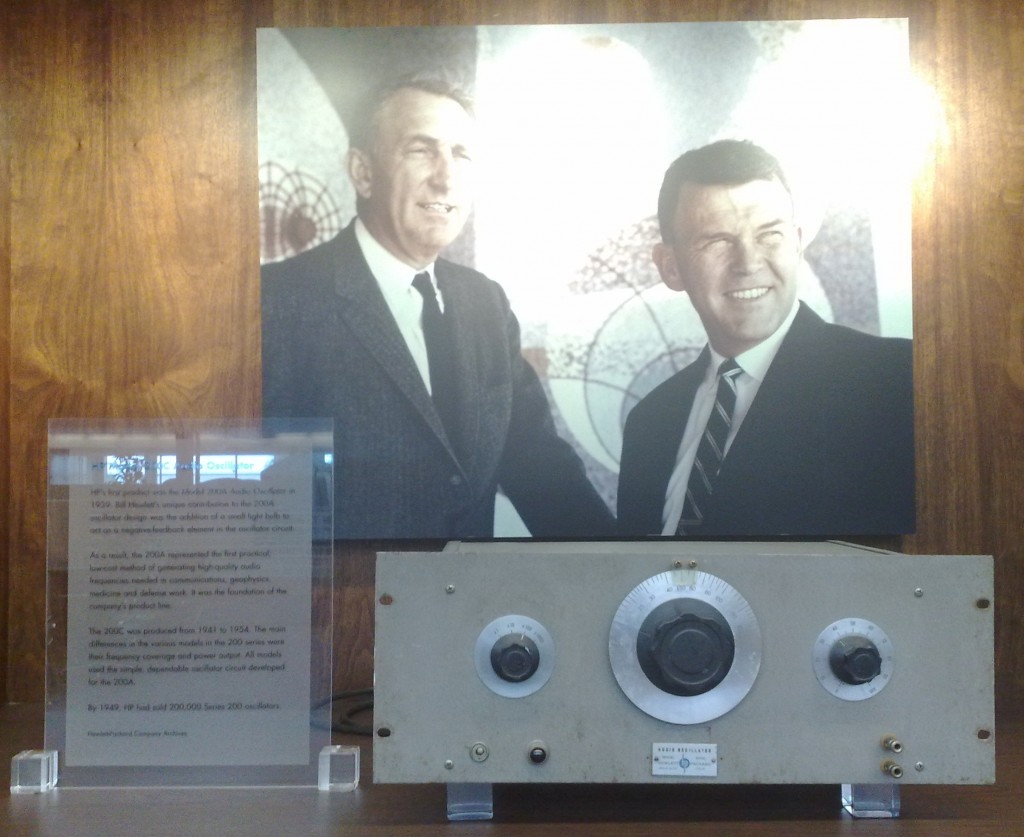- Posted May 21, 2013, 5 p.m. - 12 years, 2 months ago
HP (Hewlett-Packard) Through The Years
On May 20th one hundred years ago, William “Bill” Redington Hewlett was born. In 1935 William (better known as Bill) graduated from Stanford University, California with a degree in Electrical Engineering. At Stanford University is where he met David Packard who also graduated with the same degree, who together formed Hewlett-Packard from a garage in Palo Alto.
Here is a brief look at the growth through the years….
January 1st 1939
Hewlett-Packard (HP) was established from a garage with an initial capital investment of 538 US Dollars.
$5,369 revenue, 2 employees.
July 11th 1939
Hewlett patented the design for their first product, the HP200A.
1941
Bill serves as a U.S. Army officer until 1947, David runs the company while Bill is serving for his country.
January 6th 1942
The HP200A was granted and manufactured, it was a low-distortion audio oscillator used for testing sound equipment and were sold for $54.40.
$522,803 Revenue, 8 Employees.
August 18th 1947
HP incorporated, Dave is named president of the company and Bill is Vice president.
$851,287 Revenue, 111 Employees.
1951
The 524A high-speed frequency counter was invented, used to measure high frequencies in very short times.
$5.5 million Revenue, 215 Employees.
November 6th 1957
The company went public with shares selling for $16.
1958
HP establishes a division structure, with each product group becoming a self-sustaining organization responsible for developing, manufacturing and marketing its products.
$28 million Revenue, 1,778 employees.
1959
The company goes global, setting up a manufacturing plant in Germany and establishing marketing organizations with Switzerland.
March 17th 1961
The company was listed in its first New York Stock Exchange.
1962
HP named 460th in the fortune list.
$110 million, 6,260 Employees.
1963
HP invented the HP5100A, frequency synthesizer, used for deep space shuttles.
1964
Dave is made CEO and chairman of HP and Bill is elected president.
HP5060A atomic clock was invented, very accurate and was set for the new standards for international time.
1966
HP opens its first laboratories for creating their new ideas.
Barney Oliver becomes founding director.
The company creates its first computer, the HP2116A, was designed to withstand environmental extremes and was the world’s first go-anywhere, do-anything computer.
$203 million, 11,309 employees.
1968
The world’s first desktop scientific calculator is invented, the HP 9100A, it was 10 times faster than most machines at solving science and engineering problems and sold for $5,000
1969
Dave Packard becomes Deputy Secretary of Defence for the U.S. and serves till 1972. Bill becomes CEO in Dave’s absence.
$326 million, 15,840 employees.
1971
HP produces a laser interferometer capable of taking infinitesimal measurements, positioning HP as a world leader in the market.
1972
The HP 3000 computer was invented which started the distributed data processing era.
The world’s first hand-held scientific calculator (HP-35) was invented, small enough to fit in a shirt pocket.
$661 million, 28,255 employees.
1974
The company produces the first minicomputer using dynamic random access memory chips rather than magnetic cores.
Plus world’s first programmable pocket calculator was invented.
1977
HP introduce the HP-01, world’s first digital wristwatch, calculator and personal calendar all-in-one.
Bill retires as president but remains as the CEO, but one year later (1978) Bill retires as CEO, John Young becomes new CEO.
$1.4 billion, 35,062 employees.
1980
HP produces the HP-85, its first personal computer
$2.4 billion, 52,030 employees.
1981
HP-12C was introduced, it is a business calculator which has become the world’s standard financial calculator and is still being sold today.
1982
The HP-75C was debuted as HP’s first handheld computer which was able to connect to digital cassette drives and printers.
The HP 9000 was introduced and was a technical computer and the first desktop mainframe and was as powerful as the room sized computers in the 60s.
The company introduced the world’s first mail systems wide-area commercial network.
$4.3 billion, 69,538 employees.
1983
The introduction of the HP-150 touchscreen PC.
1984
HP inkjet and LaserJet printers take off and become the world’s most used desktop computers.
1986
On March 3, 1986, HP registered the HP.com domain name, making it the ninth Internet .com domain ever to be registered.
HP becomes the first major computer company to introduce a precision architecture based on reduced instructions set computing (RISC) making computers faster and less expensive. The effort
takes five years and is HP’s most expensive R&D effort to date.
1988
HP DeskJet printer launches and is the companies’ first mass-market inkjet printer.
$9.8 billion, 87,000 employees.
1991
The HP DeskJet 500C revolutionary colour printer was introduced and was affordable.
HP 95LX palmtop PC was an advancement of their earlier portable computer which was lightweight and roughly the size of a pocket calculator, it had as much computing power as a desktop PC.
$14.5 billion, 89,000 employees.
1993
The Super portable HP OmniBook 300 was produced weighing (1.4-kilogram).
HP shipped its10 millionth LaserJet printers.
Dave Packard retired.
$20 billion, 96,000 employees.
1994
The HP officeJet personal all-in-one (printer-fax-copier) was the world’s first mass-market device.
HP invented the world’s brightest LED’s for applications in cars, traffic lights and moving-message signs.
The 64-bit microprocessor architecture was developed with Intel.
1995
HP enters the home computing market with the HP Pavilion PC.
Dave Packard publishes The HP Way.
$31.5 billion, 105,200 employees.
1996
Dave Packard dies aged 83.
HP recycles its 10 millionth LaserJet Print cartridge.
2000
The Superdrome server line was introduced, giving an advance position in internet infrastructure.
$42 billion, 84,400 employees.
2001
Bill Hewlett dies aged 87.
HP creates HP Services to provide consulting, outsourcing, support and solutions deployment.
2002
First global brand advertising campaign, called “everything is possible”.
HP announces breakthroughs in molecular electronics in the emerging field of nanotechnology.
In May 2002 HP merges with Compaq and serves more than one billion customers in 162 countries.
HP announces new colour printers (HP DeskJet 5550) and paper that deliver results surpassing traditional prints in photo quality and fade resistance.
$56.6 billion, 141,000 employees.
2004
HP rank 11th in the fortune list.
New digital entertainment products including Flat-panel TV’s (plasma & LCD) and the HP digital Entertainment Centre was introduced.
HP wins the Corporate Innovation Award from the Institute of Electrical and Electronic Engineers (IEEE) for the development and commercialization of thermal inkjet technology.
$80 billion, 150,000 employees.
2005
In April creates SnapFish an online photo service.
In July, HP announces a breakthrough ink-based printing platform. The inkjet printhead is fabricated as one unit via a photolithographic process, rather than welded together in post-production.
HP unveils the HP Officejet Pro K550 which is the world’s fastest home and office photo printing device.
In December, HP disrupts the traditional video conferencing market by introducing the HP Halo Collaboration Studio.
2007
HP introduces the TouchSmart PC, an all-in-one PC with a touch-screen display. HP also introduces a touch-screen consumer tablet PC.
$104.3 billion, 172,000 employees.
2008
In April, HP introduces a full-function, mini-notebook: the HP 2133 Mini-Note PC.
$118.4 billion, 321,000 employees.
2011
HP introduces the industry’s first wireless mouse. The HP Wi-Fi Mobile Mouse is the first mouse to connect quickly and easily without a USB dongle via a PC’s built-in Wi-Fi receiver.
$126 billion, employees 324,600.
2013
HP now have introduced a laptop and tablet all-in-one the HP ENVY x2 11t-g000, which the keyboard can detach making it into a tablet.
Latest Articles
-
Our latest testimonial for Infix 6
Dec. 19, 2016, 2:40 p.m. -
Most commonly translated Turkish words
Feb. 6, 2015, 9 a.m. -
Merry Christmas & A Happy New Year
Dec. 25, 2016, 8 a.m. -
New Save PDF to SVG feature introduced to Spire.Office
Dec. 23, 2016, 11:54 a.m. -
Editing educational PDFs – a user perspective
July 21, 2014, 8:03 a.m.



